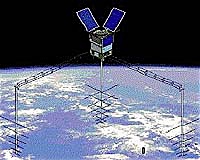Supercomputer in Space
Los Alamos scientists preparing a new generation
of computers for spacecraft.

Cibola satellite
Scientists at Los Alamos National Laboratory said they are preparing to test a new computing technology that could dramatically increase the capabilities of spacecraft.
The project - jointly sponsored by the Department of Defense and the National Nuclear Security Administration’s Office of Nonproliferation Research and Development - involves orbiting an experimental payload this fall that is capable of performing more than 1 trillion operations per second.
That much capability would match the power of the best supercomputers from a decade ago - except those machines occupied as much as 50,000 cubic feet and required up to 50,000 watts of electrical power. The new technology - driven by a 90-nanometer Virtex-4 microprocessor developed by Xilinx Inc. of San Jose, Calif. - weighs only 40 pounds and requires only 80 watts of power.
The test will be conducted aboard the Cibola Flight Experiment, due to be launched aboard a U.S. Air Force Atlas-V rocket in September from Cape Canaveral Air Force Station, Fla….The experiment will use a network of reprogrammable and field programmable gate arrays to process the received signals for ionospheric and lightning studies. The objective is to detect and measure impulsive events that occur in a complex background and would overload existing space-based computer systems.
The research partners said the technology also is aimed at boosting the power of Software-Defined Radio functions, a critical element of the military’s tactical communications, and the system could be of great value to commercial television and radio broadcasting.
Overdue.
Posted: Mon - May 1, 2006 at 06:05 AM